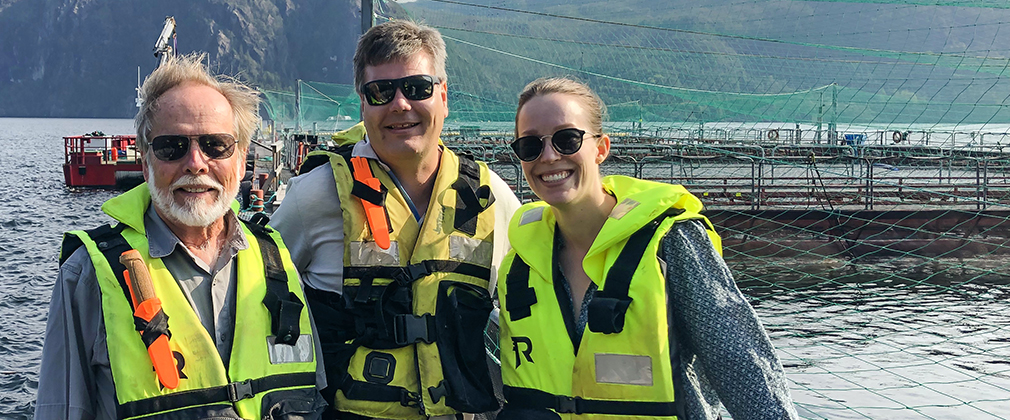Atlantic Salmon in the Norwegian Fjords
NORWAY—August 2019. With more than a thousand fjords, Norway is more than just a tourist destination of breathtaking beauty—it’s also the world’s leading producer of farm-raised Atlantic salmon. The fjords, a result of millions of years of glacial activity, are the linchpin of the country’s aquaculture industry. They are deep inlets of oceanwater, protected by steep mountainsides, and they have water that is saline, cold and kept clean by strong water currents—perfect for farming salmon.
Geography isn’t the only factor contributing to the industry’s efficiency, and therefore profitability, though. Norway is committed to renewable energy, and the entire country runs on hydroelectricity. And salmon farming, which is quite energy-intensive, benefits from that.
“These operations are very high-tech, very mechanized,” says researcher Liz Nussbaumer. “They put millions of dollars into their facilities, and the facilities produce very little waste.”
Nussbaumer, a project director at the Johns Hopkins Center for a Livable Future, traveled to Norway in August (2019) to gather data about how Norwegian farmers raise Atlantic salmon. She and two collaborators, Mark Brown and Frank Asche from the University of Florida, met with stakeholders in the industry and visited processing plants, freshwater grow-out facilities, and saltwater grow-out facilities (also referred to as net-pens).
This investigation is one piece of a larger study of seafood waste and resource use, funded by the US Department of Agriculture National Institute of Food and Agriculture. The ultimate goal of the research is to identify opportunities to increase efficiency in order to meet dietary needs with available resources. Nussbaumer and the team administered surveys to help them identify ways in which the Norwegian producers increase efficiency, and perhaps where there could be opportunities for further savings of energy and resources.
“The fjords are so deep, and they have good water currents, so the operators really benefit from these conditions ,” says Nussbaumer. “They also have strict regulations.”
Norway requires operators to let their sites “lie fallow” for periods of time, so that the fjords with net-pen operations where salmon are raised have time to restore themselves.
Nussbaumer and team visited three processing plants, where the salmon are slaughtered and then gutted or filleted or further processed. They visited three freshwater grow-out facilities, as well, where the young salmon begin their lives. (As they become smolt, or near-adults, they transition to seawater.) There’s almost zero waste occurring at the processors. The silage, that is, fish heads, guts, trimmings and “floor fish,” is used to make fish meal, pet food, fish oil or another byproduct.
“Everything that can be monetized is monetized,” she says. “There isn’t a lot of waste because waste means wasted money.”
The freshwater grow-out facilities are on land, in recirculating systems. (Recirculating aquaculture systems filter and recycle water from fish tanks.) All of the recirculating plants on land take on fresh water, of which there’s an abundance in Norway, and treat it, filter it and put it back into the fjords.
The team also visited a feed mill, where fish feed is produced. Nussbaumer noted that the operators prefer feed with some content coming from marine ingredients, as opposed to heavily plant-based feed that uses, for example, soy protein.
“They told me, the plant-based feed doesn’t perform as well, the fish don’t respond to it as much. You still need to have some sort of fish meal or algae oil,” she says.
The team found that the only sectors that use water (and don’t “return” it) is the feed sector and processors, who use ice to pack salmon for transport. In addition, they found that the operators do not use antibiotics with the salmon. They found that over time the drugs became ineffective as the pathogens developed resistance to them.
“They focus on water quality and fish health, almost obsessively,” says Nussbaumer.
The research will be underway until 2020, and lifecycle analysis data will be analyzed by collaborators based in Florida and Italy. The team expects findings by 2021.
The USDA study is funded through the Innovations at the Nexus of Food, Energy and Water Systems (INFEWS) Initiative. For more information about the INFEWS project, click here.
To read about Pangasius farming in Vietnam (another part of the INFEWS project), click here.
Image: From left, Mark Brown, Frank Asche and Liz Nussbaumer, 2019, Norway.
